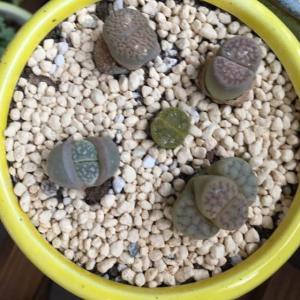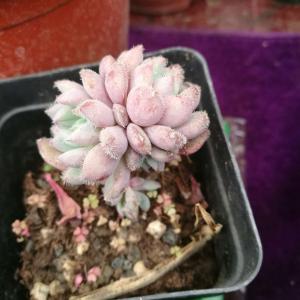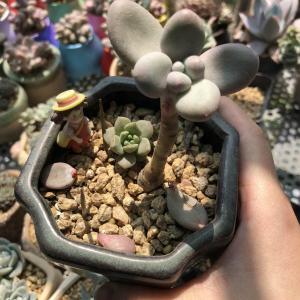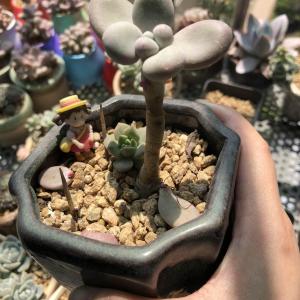文章
Miss Chen
2018年04月04日

Description: This perennial plant is 2-3' tall and little branched, except near the apex. The erect central stem is whitish green, bluntly 4-angled, and finely pubescent. The opposite leaves are up to 3" long and 1½" across; they are ovate in shape and crenate along their margins. The upper leaf surface is pale-medium or yellowish green and glabrous or nearly so (except for young leaves), while the lower leaf surface is whitish green and finely pubescent. The pubescence on the elevated veins of the leaf undersides is somewhat longer than the pubescence between the veins. The petioles are short (up to ½" in length), whitish green, and finely pubescent. From the middle to upper leaf axils, short secondary stems with smaller leaves may form.
Racemes of Flowers
The upper stems terminate in spike-like racemes of flowers up to 6" in length. These racemes are held upright and they have densely-spaced pairs of flowers. Each flower has a 2-lipped tubular corolla about ¾" long that is mostly blue-violet, and a short tubular calyx about ¼" long that is whitish green and finely pubescent. The reproductive organs of the flower are inserted within the corolla. The upper lip of the corolla is hood-like with lateral margins that are curled back, while its lower lip is larger and broader; there is a conspicuous patch of white in front of the throat of corolla. A very fine pubescence (canescence) covers the outer surface of the flower, particularly on the hood (visible with a 10x hand lens). The calyx has a conspicuous protuberance on its upper side. Both the central rachis of each raceme and the pedicels of the flowers (up to ¼" in length) are whitish green and finely pubescent. At the base of each pedicel on a raceme, there is a small leafy bract up to ½" long that is lanceolate or elliptic in shape. None of the hairs on this plant are glandular or sticky.

The blooming period occurs from mid- to late summer, lasting about 1-1½ months. There is no noticeable floral scent. The flowers are replaced by oddly shaped capsules that contain 2-4 nutlets. The upper surface of each capsule is concave with a protuberance on one side. At maturity, these capsules turn brown and split open to release their nutlets; this process may be facilitated by raindrop logistics. The root system is rhizomatous, often forming tight colonies of clonal plants.
Cultivation: The preference is partial sun and mesic to dry-mesic conditions. Full sun or light shade and moist conditions are also tolerated. The soil can contain loam, clay-loam, or some rocky material, which corresponds to the conditions in which this plant normally grows. Foliar disease rarely bothers this plant; some of the lower leaves may turn yellow and drop off the stem if there is a severe drought, but this member of the Mint family withstands dry conditions rather well. Occasionally, insects may chew holes in the leaves, sometimes causing major damage. Overall, this plant is easy to grow in a garden setting.

Range & Habitat: The native Downy Skullcap occurs occasionally in the southern half of Illinois, while in the rest of the state it is largely absent (see Distribution Map). Illinois lies along the northern range limit of this species. Habitats include upland forests, rocky slopes of woodlands, thinly wooded bluffs, rocky slopes along rivers, upland meadows in wooded areas, thickets, and roadsides that run through woodlands. Downy Skullcap usually occurs in and around upland forests, but it occasionally strays into adjacent meadows. This plant is usually found in higher quality natural areas.

Faunal Associations: The flowers are pollinated by bumblebees primarily, which suck nectar or collect pollen. Less common visitors are bee flies, skippers, or small butterflies, but these visitors are less likely to cross-pollinate the flowers. Some species of wasps may perforate the base of the flower and steal nectar (specifically, the Eumenid wasp Euodynerus foraminatus has been observed to do this), and Halictid bees sometimes take advantage of these perforations to suck nectar themselves. Insects that feed destructively on Downy Skullcap and other Skullcaps (Scutellaria spp.) include the flea beetles Phyllobrotica circumdata and Phyllobrotica limbata, the leaf-mining larvae of Caloptilia scutellariella (Skullcap Caloptilia Moth), and the larvae of Prochoreutis inflatella (Skullcap Skeletonizer Moth). Because the foliage is bitter-tasting and possibly toxic, mammalian herbivores usually don't bother this plant to any significant degree.

Photographic Location: The photographs were taken at the webmaster's wildflower garden in Urbana, Illinois.
Comments: Downy Skullcap has attractive foliage and flowers; it is one of the more showy species in this genus. It is similar to Agastache foeniculum (Anise Hyssop) in the appearance of its foliage and habitat preferences, but its flowers are larger and more attractive. Therefore, it's surprising that this plant is not grown in flower gardens more often. Distinguishing Scutellaria spp. (Skullcaps) is rather tricky, but here are some key characteristics of Downy Skullcap: 1) Except for the lowest leaves, the leaf bases are well-rounded, rather than heart-shaped; 2) this species of Skullcap blooms later and grows taller than most; 3) except for the upper leaf surfaces, the entire plant is finely pubescent, and it has no sticky glandular hairs; and 4) the racemes of its flowers are terminal, rather than axillary.
Racemes of Flowers
The upper stems terminate in spike-like racemes of flowers up to 6" in length. These racemes are held upright and they have densely-spaced pairs of flowers. Each flower has a 2-lipped tubular corolla about ¾" long that is mostly blue-violet, and a short tubular calyx about ¼" long that is whitish green and finely pubescent. The reproductive organs of the flower are inserted within the corolla. The upper lip of the corolla is hood-like with lateral margins that are curled back, while its lower lip is larger and broader; there is a conspicuous patch of white in front of the throat of corolla. A very fine pubescence (canescence) covers the outer surface of the flower, particularly on the hood (visible with a 10x hand lens). The calyx has a conspicuous protuberance on its upper side. Both the central rachis of each raceme and the pedicels of the flowers (up to ¼" in length) are whitish green and finely pubescent. At the base of each pedicel on a raceme, there is a small leafy bract up to ½" long that is lanceolate or elliptic in shape. None of the hairs on this plant are glandular or sticky.

The blooming period occurs from mid- to late summer, lasting about 1-1½ months. There is no noticeable floral scent. The flowers are replaced by oddly shaped capsules that contain 2-4 nutlets. The upper surface of each capsule is concave with a protuberance on one side. At maturity, these capsules turn brown and split open to release their nutlets; this process may be facilitated by raindrop logistics. The root system is rhizomatous, often forming tight colonies of clonal plants.
Cultivation: The preference is partial sun and mesic to dry-mesic conditions. Full sun or light shade and moist conditions are also tolerated. The soil can contain loam, clay-loam, or some rocky material, which corresponds to the conditions in which this plant normally grows. Foliar disease rarely bothers this plant; some of the lower leaves may turn yellow and drop off the stem if there is a severe drought, but this member of the Mint family withstands dry conditions rather well. Occasionally, insects may chew holes in the leaves, sometimes causing major damage. Overall, this plant is easy to grow in a garden setting.

Range & Habitat: The native Downy Skullcap occurs occasionally in the southern half of Illinois, while in the rest of the state it is largely absent (see Distribution Map). Illinois lies along the northern range limit of this species. Habitats include upland forests, rocky slopes of woodlands, thinly wooded bluffs, rocky slopes along rivers, upland meadows in wooded areas, thickets, and roadsides that run through woodlands. Downy Skullcap usually occurs in and around upland forests, but it occasionally strays into adjacent meadows. This plant is usually found in higher quality natural areas.

Faunal Associations: The flowers are pollinated by bumblebees primarily, which suck nectar or collect pollen. Less common visitors are bee flies, skippers, or small butterflies, but these visitors are less likely to cross-pollinate the flowers. Some species of wasps may perforate the base of the flower and steal nectar (specifically, the Eumenid wasp Euodynerus foraminatus has been observed to do this), and Halictid bees sometimes take advantage of these perforations to suck nectar themselves. Insects that feed destructively on Downy Skullcap and other Skullcaps (Scutellaria spp.) include the flea beetles Phyllobrotica circumdata and Phyllobrotica limbata, the leaf-mining larvae of Caloptilia scutellariella (Skullcap Caloptilia Moth), and the larvae of Prochoreutis inflatella (Skullcap Skeletonizer Moth). Because the foliage is bitter-tasting and possibly toxic, mammalian herbivores usually don't bother this plant to any significant degree.

Photographic Location: The photographs were taken at the webmaster's wildflower garden in Urbana, Illinois.
Comments: Downy Skullcap has attractive foliage and flowers; it is one of the more showy species in this genus. It is similar to Agastache foeniculum (Anise Hyssop) in the appearance of its foliage and habitat preferences, but its flowers are larger and more attractive. Therefore, it's surprising that this plant is not grown in flower gardens more often. Distinguishing Scutellaria spp. (Skullcaps) is rather tricky, but here are some key characteristics of Downy Skullcap: 1) Except for the lowest leaves, the leaf bases are well-rounded, rather than heart-shaped; 2) this species of Skullcap blooms later and grows taller than most; 3) except for the upper leaf surfaces, the entire plant is finely pubescent, and it has no sticky glandular hairs; and 4) the racemes of its flowers are terminal, rather than axillary.
0
0
文章
Miss Chen
2018年04月04日

Description: This herbaceous plant is a short-lived perennial that forms a rosette of basal leaves; it later bolts to form a flowering stalk that becomes 1–3' tall. The basal leaves are 2½–6" long and 1–3½" across and variably shaped; they are ovate, obovate, oblanceolate, or broadly elliptic in outline. The majority of basal leaves are pinnatifid with a larger terminal lobe and 1-3 pairs of smaller lateral lobes. These lobes are rounded, shallow to deep, and somewhat undulate. Some basal leaves lack significant lobes, however, and their margins are merely undulate. In addition, some basal leaves may have blunt dentate teeth. The whitish and relatively stout petioles of the basal leaves are ¾–3½" long; they are concave above, convex below, and sparsely to moderately hairy.
The flowering stalk is light to medium green, sparsely to moderately hairy, and 4-angled. Along the lower one-half of its length, there are 0-2 pairs of opposite leaves (usually a single pair). The opposite leaves are 1–3" long, ¼–1" across, and sessile (or nearly so); they are elliptic to broadly elliptic in shape or, less often, shallowly pinnatifid. The margins of the opposite leaves are either toothless or they may have blunt dentate teeth. The leaf surfaces of both basal and opposite leaves are medium to dark green, sometimes with purplish coloration; they are sparsely hairy. Leaf venation is pinnate. The inflorescence consists of a spike-like raceme of whorled flowers about ½–1½' long; the whorls of flowers are remotely spaced along the central stalk, and there are 4-12 flowers per whorl (typically about 6). Each flower is about ¾–1" long, consisting of a light blue-violet or lavender corolla, a medium green calyx, 2 fertile stamens and 2 infertile residual stamens, a slender style with a bifurcated tip, and a 4-celled ovary.

The corolla is tubular-funnel shaped (widest at its mouth, tapering gradually toward its base) and two-lipped. The upper lip is smaller in size and divided into 3 rounded lobes (1 upper lobe and 2 lateral lobes), while the lower lip is larger in size, slightly notched, and often whitish. The 2-lipped calyx has 3 small upper teeth that are little more than awns and 2 larger lower teeth that taper into awn-like tips; the entire calyx is angular-ribbed and wider at its mouth than its base. The outer surface of the corolla has sparse fine pubescence, while the outer surface of the calyx is sparsely hairy. The pedicels of the flowers are less than ¼" long and pubescent. The blooming period occurs from mid-spring to early summer, lasting about 1 month. Afterwards, each flower is replaced by 4 dark brown to black nutlets that are about 2 mm. in length. and ovoid in shape. The root system consists of a shallow crown with coarse fibrous roots.
Cultivation: The preference is full sun to light shade, moist to dry-mesic conditions, and soil containing sand, rocky material, or gravel. However, ordinary garden soil containing loam or clay-loam is acceptable if competition from taller plants is eliminated or reduced. Northern ecotypes of this plant are more likely to be winter-hardy in colder regions.

Range & Habitat: Lyre-leaved Sage (Salvia lyrata) is occasional in southern Illinois, where it is native (see Distribution Map). Illinois lies along the northwestern range-limit of this plant. Habitats include upland woodlands in rocky areas, areas adjacent to woodland paths, rocky semi-wooded slopes, upland savannas, edges and upper slopes of bluffs, limestone or sandstone glades, sandbars and gravel bars along rivers, semi-shaded roadsides, and pastures. This plant is sometimes cultivated in flower gardens, especially cultivars with purplish foliage. Outside of the state, Lyre-leaved Sage is often found in sandy habitats. In Illinois, it is found in both high quality habitats and more degraded sites.
Faunal Associations: Smith et al. (2012) observed large carpenter bees (Xylocopa), leaf-cutting bees (Megachile), and mason bees (Hoplitis, Osmia) visiting the flowers (probably for nectar). Mourning Doves eat the seeds (Lewis, 1993). The foliage of this plant is probably avoided as a food source by most mammalian herbivores. It is possible that the awn-like tips of the calyces may cling to the fur of mammals, dispersing the seeds to new areas.

Photographic Location: Along a woodland path at the Portland Arch Nature Preserve in west-central Indiana.
Comments: Except for Wild Blue Sage (Salvia azurea), Lyre-leaved Sage (Salvia lyrata) is the only native sage (Salvia) in Illinois. All of the others are either adventive from areas further to the west, or they were introduced from abroad as ornamental plants and culinary herbs. Lyre-leaved Sage is remarkable for the variability of its basal leaves. Because other sages and similar species in the Mint family in Illinois have mostly opposite leaves, rather than basal leaves, it is relatively easy to identify. Another common name of this plant is Cancer Weed.
The flowering stalk is light to medium green, sparsely to moderately hairy, and 4-angled. Along the lower one-half of its length, there are 0-2 pairs of opposite leaves (usually a single pair). The opposite leaves are 1–3" long, ¼–1" across, and sessile (or nearly so); they are elliptic to broadly elliptic in shape or, less often, shallowly pinnatifid. The margins of the opposite leaves are either toothless or they may have blunt dentate teeth. The leaf surfaces of both basal and opposite leaves are medium to dark green, sometimes with purplish coloration; they are sparsely hairy. Leaf venation is pinnate. The inflorescence consists of a spike-like raceme of whorled flowers about ½–1½' long; the whorls of flowers are remotely spaced along the central stalk, and there are 4-12 flowers per whorl (typically about 6). Each flower is about ¾–1" long, consisting of a light blue-violet or lavender corolla, a medium green calyx, 2 fertile stamens and 2 infertile residual stamens, a slender style with a bifurcated tip, and a 4-celled ovary.

The corolla is tubular-funnel shaped (widest at its mouth, tapering gradually toward its base) and two-lipped. The upper lip is smaller in size and divided into 3 rounded lobes (1 upper lobe and 2 lateral lobes), while the lower lip is larger in size, slightly notched, and often whitish. The 2-lipped calyx has 3 small upper teeth that are little more than awns and 2 larger lower teeth that taper into awn-like tips; the entire calyx is angular-ribbed and wider at its mouth than its base. The outer surface of the corolla has sparse fine pubescence, while the outer surface of the calyx is sparsely hairy. The pedicels of the flowers are less than ¼" long and pubescent. The blooming period occurs from mid-spring to early summer, lasting about 1 month. Afterwards, each flower is replaced by 4 dark brown to black nutlets that are about 2 mm. in length. and ovoid in shape. The root system consists of a shallow crown with coarse fibrous roots.
Cultivation: The preference is full sun to light shade, moist to dry-mesic conditions, and soil containing sand, rocky material, or gravel. However, ordinary garden soil containing loam or clay-loam is acceptable if competition from taller plants is eliminated or reduced. Northern ecotypes of this plant are more likely to be winter-hardy in colder regions.

Range & Habitat: Lyre-leaved Sage (Salvia lyrata) is occasional in southern Illinois, where it is native (see Distribution Map). Illinois lies along the northwestern range-limit of this plant. Habitats include upland woodlands in rocky areas, areas adjacent to woodland paths, rocky semi-wooded slopes, upland savannas, edges and upper slopes of bluffs, limestone or sandstone glades, sandbars and gravel bars along rivers, semi-shaded roadsides, and pastures. This plant is sometimes cultivated in flower gardens, especially cultivars with purplish foliage. Outside of the state, Lyre-leaved Sage is often found in sandy habitats. In Illinois, it is found in both high quality habitats and more degraded sites.
Faunal Associations: Smith et al. (2012) observed large carpenter bees (Xylocopa), leaf-cutting bees (Megachile), and mason bees (Hoplitis, Osmia) visiting the flowers (probably for nectar). Mourning Doves eat the seeds (Lewis, 1993). The foliage of this plant is probably avoided as a food source by most mammalian herbivores. It is possible that the awn-like tips of the calyces may cling to the fur of mammals, dispersing the seeds to new areas.

Photographic Location: Along a woodland path at the Portland Arch Nature Preserve in west-central Indiana.
Comments: Except for Wild Blue Sage (Salvia azurea), Lyre-leaved Sage (Salvia lyrata) is the only native sage (Salvia) in Illinois. All of the others are either adventive from areas further to the west, or they were introduced from abroad as ornamental plants and culinary herbs. Lyre-leaved Sage is remarkable for the variability of its basal leaves. Because other sages and similar species in the Mint family in Illinois have mostly opposite leaves, rather than basal leaves, it is relatively easy to identify. Another common name of this plant is Cancer Weed.
0
0
文章
绿手指客服
2018年04月04日

绿手指君感谢各位花友两年来的支持!
最近正在筹划给大家准备点礼物,请大家投票帮我决定哈!投票也是有奖品哒!😘😘
参与方式如下⬇️
1. 进入发现页面,点击上面活动图片进入活动页面
2. 下面是活动页面,选择三个你最喜欢的选项,点击投票!
3. 投票成功,就能获得打开宝箱的机会!继续分享给好友还能再次获得打开宝箱的机会!
4. 喜欢什么一定要告诉我哦!绿手指君在这里等你来😘😘😘😘😘
最近正在筹划给大家准备点礼物,请大家投票帮我决定哈!投票也是有奖品哒!😘😘
参与方式如下⬇️
1. 进入发现页面,点击上面活动图片进入活动页面

2. 下面是活动页面,选择三个你最喜欢的选项,点击投票!

3. 投票成功,就能获得打开宝箱的机会!继续分享给好友还能再次获得打开宝箱的机会!

4. 喜欢什么一定要告诉我哦!绿手指君在这里等你来😘😘😘😘😘
10
2
JNN:点了投票没反应
iKa:支持支持😍
刚得了一年的免费VIP😁
lrgarden:@Miss Chen 下载最新版绿手指,然后参加这个活动就能领红包
绿手指客服:@Miss Chen 进我的礼品架 你的奖品都放在里面。点击使用按步骤操作就行啦🙃
Miss Chen:@一花一世界 怎么买呢?
显示更多
文章
Miss Chen
2018年04月03日

Description: This perennial wildflower is about 1½-2½' tall, branching occasionally. Low basal leaves are produced initially that are oval in shape and dentate along their margins; their bases are rounded to slightly cordate. Later, stems are produced that are light green with spreading white hairs. The alternate leaves are up to 5" long and 2½" across, becoming smaller and more narrow as they ascend the stems. Alternate leaves are ovate, broadly elliptic, or elliptic in shape, and dentate along their margins. The upper surface of each leaf is either hairless or sparsely covered with short appressed hairs; it is medium to dark green. The base of each alternate leaf tapers to a winged petiole; the base of the petiole is either sessile or clasps the stem.
The upper stems terminate in individual flowerheads spanning 2-3" across. Each flowerhead consists of 10-20 ray florets surrounding numerous tiny disk florets. The petal-like rays of the ray florets are yellow to orange-yellow with notched tips; they spread outward from the center of the flowerhead. The tiny disk florets are dark brownish purple and tubular-shaped. Each disk floret has 5 tiny lobes along its upper rim that are erect, rather than spreading outward. Each disk floret has a divided style with blunt tips. The blooming period occurs from mid-summer into the fall and lasts about 2 months. The mature achenes are oblongoid, 4-angled, and black; the upper end of each achene is truncate with a minute crown of tiny teeth (the pappus). Each achene is about 3 mm. in length or a little less. These achenes are light weight and can be blown about by the wind, but they usually don't stray far from the mother plant. The root system is fibrous and rhizomatous. In open disturbed areas, vegetative colonies are often formed from the rhizomes.
Cultivation: The preference is partial to full sun, moist to mesic conditions, and loamy or rocky soil that contains organic material. At a dry sunny site, there is a tendency for the leaves to wilt and the flowerheads may not develop properly. This coneflower requires cross-pollination with genetically distinct plants to produce viable seeds.

Range & Habitat: Sullivant's Coneflower is an uncommon native wildflower that is found primarily in scattered counties in the eastern half of Illinois (see Distribution Map). Habitats of this coneflower are rather variable: they include moist rocky woodlands, savannas and barrens, woodland openings and edges, moist meadows, limestone glades, moist rocky ledges, fens, hillside seeps, and swamps. Sullivant's Coneflower is typically found in high quality natural habitats, but it will temporarily colonize open disturbed areas.
Faunal Associations: Like other Rudbeckia spp., the showy flowerheads of Sullivant's Coneflower attract their fair share of pollinating insects; both nectar and pollen are available as floral rewards. Floral insect visitors include bees (leaf-cutting bees, Andrenid bees, Halictid bees), small butterflies and skippers, various flies (especially Syrphid flies and bee flies), and sometimes beetles (soldier beetles, weevils). Several moth caterpillars are known to feed on Rudbeckia spp.; they are usually found on the flowerheads, and include such species as Chlorochlamys chloroleuca (Blackberry Looper Moth), Eupithecia miserulata (Common Eupithecia), Synchlora aerata (Wavy-Lined Emerald), and Homoeosoma electellum (Sunflower Moth). Mammalian herbivores that browse on the foliage include deer, rabbits, groundhogs, cattle, and other farm animals.
Photographic Location: The wildflower garden of the webmaster in Urbana, Illinois.

Comments: Orange Coneflower (Rudbeckia fulgida) is quite variable in appearance from one site to another. Consequently, this species has been a source of taxonomic problems that continues to this day. Some authorities classify Orange Coneflower as a single species consisting of several varieties, while others regard it as a complex of several closely-related species. Here, Sullivant's Coneflower is treated as a variety of Orange Coneflower. Sullivant's Coneflower can be distinguished from these other varieties by its larger flowerheads (typically 2-3" across) and the shape of its leaves. Other varieties of Rudbeckia fulgida that may be encountered in Illinois include: Rudbeckia fulgida fulgida (Orange Coneflower), which has more slender leaves and smaller flowerheads (1-2" across); Rudbeckia fulgida deamii (Deam's Coneflower), which has more hairy stems, smaller flowerheads (1-2" across), and larger upper leaves; and Rudbeckia fulgida speciosa (Showy Coneflower), which has slightly smaller flowerheads (1½-2½" across) and lower leaves that are more narrow and shallowly cleft. Among these different varieties, Sullivant's coneflower is the one that is most often cultivated in gardens. It is also possible to confuse Sullivant's Coneflower with the common Rudbeckia hirta (Black-Eyed Susan) in appearance, but it can be distinguished from the latter species as follows: 1) Sullivant's Coneflower has foliage that is less hairy, 2) its leaves have petioles that are conspicuously winged, 3) each of its achenes has a crown of tiny teeth, and 4) it is a perennial. In contrast, Black-Eyed Susan has more hairy foliage, its petioles lack conspicuous wings, its achenes are truncate at the apex, and it is usually annual or biennial in habit.
The upper stems terminate in individual flowerheads spanning 2-3" across. Each flowerhead consists of 10-20 ray florets surrounding numerous tiny disk florets. The petal-like rays of the ray florets are yellow to orange-yellow with notched tips; they spread outward from the center of the flowerhead. The tiny disk florets are dark brownish purple and tubular-shaped. Each disk floret has 5 tiny lobes along its upper rim that are erect, rather than spreading outward. Each disk floret has a divided style with blunt tips. The blooming period occurs from mid-summer into the fall and lasts about 2 months. The mature achenes are oblongoid, 4-angled, and black; the upper end of each achene is truncate with a minute crown of tiny teeth (the pappus). Each achene is about 3 mm. in length or a little less. These achenes are light weight and can be blown about by the wind, but they usually don't stray far from the mother plant. The root system is fibrous and rhizomatous. In open disturbed areas, vegetative colonies are often formed from the rhizomes.
Cultivation: The preference is partial to full sun, moist to mesic conditions, and loamy or rocky soil that contains organic material. At a dry sunny site, there is a tendency for the leaves to wilt and the flowerheads may not develop properly. This coneflower requires cross-pollination with genetically distinct plants to produce viable seeds.

Range & Habitat: Sullivant's Coneflower is an uncommon native wildflower that is found primarily in scattered counties in the eastern half of Illinois (see Distribution Map). Habitats of this coneflower are rather variable: they include moist rocky woodlands, savannas and barrens, woodland openings and edges, moist meadows, limestone glades, moist rocky ledges, fens, hillside seeps, and swamps. Sullivant's Coneflower is typically found in high quality natural habitats, but it will temporarily colonize open disturbed areas.
Faunal Associations: Like other Rudbeckia spp., the showy flowerheads of Sullivant's Coneflower attract their fair share of pollinating insects; both nectar and pollen are available as floral rewards. Floral insect visitors include bees (leaf-cutting bees, Andrenid bees, Halictid bees), small butterflies and skippers, various flies (especially Syrphid flies and bee flies), and sometimes beetles (soldier beetles, weevils). Several moth caterpillars are known to feed on Rudbeckia spp.; they are usually found on the flowerheads, and include such species as Chlorochlamys chloroleuca (Blackberry Looper Moth), Eupithecia miserulata (Common Eupithecia), Synchlora aerata (Wavy-Lined Emerald), and Homoeosoma electellum (Sunflower Moth). Mammalian herbivores that browse on the foliage include deer, rabbits, groundhogs, cattle, and other farm animals.
Photographic Location: The wildflower garden of the webmaster in Urbana, Illinois.

Comments: Orange Coneflower (Rudbeckia fulgida) is quite variable in appearance from one site to another. Consequently, this species has been a source of taxonomic problems that continues to this day. Some authorities classify Orange Coneflower as a single species consisting of several varieties, while others regard it as a complex of several closely-related species. Here, Sullivant's Coneflower is treated as a variety of Orange Coneflower. Sullivant's Coneflower can be distinguished from these other varieties by its larger flowerheads (typically 2-3" across) and the shape of its leaves. Other varieties of Rudbeckia fulgida that may be encountered in Illinois include: Rudbeckia fulgida fulgida (Orange Coneflower), which has more slender leaves and smaller flowerheads (1-2" across); Rudbeckia fulgida deamii (Deam's Coneflower), which has more hairy stems, smaller flowerheads (1-2" across), and larger upper leaves; and Rudbeckia fulgida speciosa (Showy Coneflower), which has slightly smaller flowerheads (1½-2½" across) and lower leaves that are more narrow and shallowly cleft. Among these different varieties, Sullivant's coneflower is the one that is most often cultivated in gardens. It is also possible to confuse Sullivant's Coneflower with the common Rudbeckia hirta (Black-Eyed Susan) in appearance, but it can be distinguished from the latter species as follows: 1) Sullivant's Coneflower has foliage that is less hairy, 2) its leaves have petioles that are conspicuously winged, 3) each of its achenes has a crown of tiny teeth, and 4) it is a perennial. In contrast, Black-Eyed Susan has more hairy foliage, its petioles lack conspicuous wings, its achenes are truncate at the apex, and it is usually annual or biennial in habit.
0
0
文章
Miss Chen
2018年04月03日

瓦松:景天科瓦松属二年生草本植物。叶互生,有刺,线形至披针形,总状紧密花序,紧密,可呈宽20厘米的金字塔形;花梗长可达1厘米,萼片长圆形,花瓣红色,披针状椭圆形,花药紫色;近四方形,蓇葖长圆形,喙细,子细小卵形多数,8-9月开花,9-10月结果。
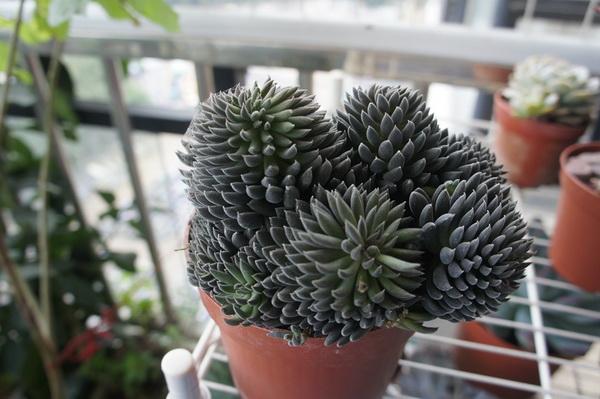
中国分布湖北、安徽、江苏、浙江、等多省。生于海拔1600米以下,在甘肃、青海可到海拔3500米以下的山坡石上或屋瓦上。朝鲜、日本、蒙古、苏联也有分布。模式标本为苏联西伯利亚地区。
瓦松具有优异的观赏应用价值: 瓦松可作为花坛花卉植于山坡、岩石园或屋顶,是一种颇具开发价值的野生花卉。
瓦松性平,味酸;有毒。有清热解毒,止血,敛疮之功能。用于泻痢、便血、月经不调、疮不收口。
瓦松是原产地植物,栽培简便,宜用排水良好,富含腐殖质的土壤,“富士”等栽培品种夏季要注意通风,高温时要控制浇水。母株会在周围产生子株,可用于繁殖。
瓦松通过人工杂交和栽培,培育了相似的小型品种。
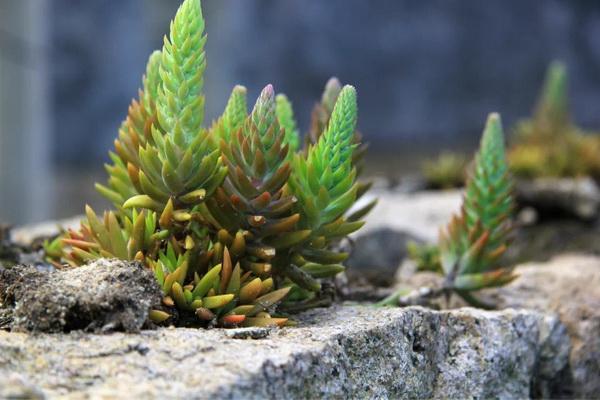
瓦松在中国传统文化中多是寄居高位的象征。唐代诗人李晔《尚书都堂瓦松》咏瓦松: “华省秘仙踪,高堂露瓦松。叶因春后长,花为雨来浓。影混鸳鸯色,光含翡翠容。天然斯所寄,地势太无从。接栋临双阙,连甍近九重。宁知深涧底,霜雪岁兼封”。寄托自己想依托权威寄居高位处庙堂之上的想法。而郑谷《菊》却云: “王孙莫把比蓬蒿,九日枝枝近鬓毛。露湿秋香满池岸,由来不羡瓦松高”对瓦松表示出不屑不羡。一些古人认为,瓦松虽能开花吐叶,但“高不及尺,下才如寸”,没有什么实际用处,所以“桐君( 医师) 莫赏,梓匠( 木工) 难甄”。郑谷以池岸边的菊花与高屋上的瓦松作对比,意在说明菊花虽生长在沼泽低洼之地,却高洁、清幽,毫不吝惜地把它的芳香献给人们; 而瓦松虽踞高位,实际上“在人无用,在物无成”。在这里,以一无所用的瓦松反衬菊花高雅而不求权位、不慕名利的情操,实际上是对瓦松价值的不了解,是古代人褒扬一个打压一个的一种写作手法,也是传统文人缺乏宽厚包容思维的偏狭思想的反映。
瓦松在今天的普通中国人心里是一种平凡而又伟大的小草,寄予了中国人甘于平凡、顽强抗争、生生不息、特立独行的人文精神。现代民间诗人陈村顽做了首《七绝·瓦松》: “瓦缝立身何畏艰? 玉躯也敢傲霜寒。莫叹不敌青松伟,风格从来无二般”,又咏: “琼枝浑似不经风,赤胆何妨济世穷。利斧骄阳双洗礼,一株灵药荐神农”,都写出了瓦松平凡中蕴蓄着伟大的精神魅力。

中国分布湖北、安徽、江苏、浙江、等多省。生于海拔1600米以下,在甘肃、青海可到海拔3500米以下的山坡石上或屋瓦上。朝鲜、日本、蒙古、苏联也有分布。模式标本为苏联西伯利亚地区。
瓦松具有优异的观赏应用价值: 瓦松可作为花坛花卉植于山坡、岩石园或屋顶,是一种颇具开发价值的野生花卉。
瓦松性平,味酸;有毒。有清热解毒,止血,敛疮之功能。用于泻痢、便血、月经不调、疮不收口。
瓦松是原产地植物,栽培简便,宜用排水良好,富含腐殖质的土壤,“富士”等栽培品种夏季要注意通风,高温时要控制浇水。母株会在周围产生子株,可用于繁殖。
瓦松通过人工杂交和栽培,培育了相似的小型品种。

瓦松在中国传统文化中多是寄居高位的象征。唐代诗人李晔《尚书都堂瓦松》咏瓦松: “华省秘仙踪,高堂露瓦松。叶因春后长,花为雨来浓。影混鸳鸯色,光含翡翠容。天然斯所寄,地势太无从。接栋临双阙,连甍近九重。宁知深涧底,霜雪岁兼封”。寄托自己想依托权威寄居高位处庙堂之上的想法。而郑谷《菊》却云: “王孙莫把比蓬蒿,九日枝枝近鬓毛。露湿秋香满池岸,由来不羡瓦松高”对瓦松表示出不屑不羡。一些古人认为,瓦松虽能开花吐叶,但“高不及尺,下才如寸”,没有什么实际用处,所以“桐君( 医师) 莫赏,梓匠( 木工) 难甄”。郑谷以池岸边的菊花与高屋上的瓦松作对比,意在说明菊花虽生长在沼泽低洼之地,却高洁、清幽,毫不吝惜地把它的芳香献给人们; 而瓦松虽踞高位,实际上“在人无用,在物无成”。在这里,以一无所用的瓦松反衬菊花高雅而不求权位、不慕名利的情操,实际上是对瓦松价值的不了解,是古代人褒扬一个打压一个的一种写作手法,也是传统文人缺乏宽厚包容思维的偏狭思想的反映。
瓦松在今天的普通中国人心里是一种平凡而又伟大的小草,寄予了中国人甘于平凡、顽强抗争、生生不息、特立独行的人文精神。现代民间诗人陈村顽做了首《七绝·瓦松》: “瓦缝立身何畏艰? 玉躯也敢傲霜寒。莫叹不敌青松伟,风格从来无二般”,又咏: “琼枝浑似不经风,赤胆何妨济世穷。利斧骄阳双洗礼,一株灵药荐神农”,都写出了瓦松平凡中蕴蓄着伟大的精神魅力。
1
0
文章
Miss Chen
2018年04月02日

Description: This woody shrub is about 2-4' tall, branching occasionally. Young branches are green, while older branches are grey or brown. They have two kinds of thorns: long thorns about ½" long that occur in groups of 1-3 near the petioles of the leaves (or where the petioles used to be located), and shorter thorns about ¼" or less that are abundant on major branches, but fewer in number or absent on smaller branches. These thorns are straight and brown to reddish brown. The leaves occur alternately along the branches in groups of 1-3. Each leaf is up to 2" long and across; it is palmately lobed and crenate along the margins. There are usually 3-5 major lobes per leaf, and several lesser lobes; they are cleft and taper to blunt tips. The upper surface of each leaf is slightly pubescent to hairless, while the lower surface is pubescent to slightly pubescent. Each leaf is cordate (indented) at the base where the petiole joins the blade. The petioles are usually hairy and up to 1½" long. Flowers are produced in groups of 1-3 near the petioles of some leaves; the inflorescence is either a branched cyme or a short raceme, from which the flowers droop downward. The slender pedicels of the flowers are green and pubescent or slightly hairy.
Each flower is about 1/3" (8 mm.) long and greenish yellow; it consists of short tubular calyx with 4-5 spreading lobes, a similar number of stamens, and a prickly or bristly ovary underneath. The short lobes are oblong to oval in shape, while the stamens extend no farther than the tubular calyx (they are not exerted). The petals are smaller than the calyx lobes and insignificant. The blooming period occurs during late spring and lasts about 2 weeks. Each fertilized flower develops into a globoid berry about 1/3" (8 mm.) across or a little larger. Immature berries are shiny and green, but they later become dull red or dull purple. All berries have conspicuous prickles. The berries are juicy and contain several minute seeds. The root system is branching and woody.
Cultivation: The preference is partial sun, mesic to dry conditions, and loamy or rocky soil. In excessive shade, flowers and fruit may fail to develop. Gooseberries and currants (Ribes spp.) are alternate hosts to White Pine Blister rust.

Range & Habitat: The native Prickly Gooseberry occurs occasionally in central and northern Illinois, while in the southern part of the state it is uncommon or absent (see Distribution Map). Habitats include thin rocky woodlands, wooded slopes, woodland borders, and limestone bluffs. Some disturbance is beneficial to this species if it reduces the overhead tree canopy.
Faunal Associations: The flowers attract honeybees, bumblebees, Large Carpenter bees, Andrenid bees, Syrphid flies, and various ants; most of these visitors suck nectar from the flowers, although Andrenid bees also collect pollen. The bees are more effective pollinators than either flies or ants. The caterpillars of the butterflies Polygonia faunus (Green Comma) and Polygonia progne (Gray Comma) feed on the foliage of Ribes spp. (Gooseberries, Currants). The Insect Table lists additional insects that feed on gooseberries and currants. Some songbirds eat the fruit, including the Catbird, Robin, Brown Thrasher, and Cedar Waxwing. Various mammals eat the fruit as well, including the Red Fox, Raccoon, Striped Skunk, Red Squirrel, Deer Mouse, and White-Footed Mouse. These animals help to distribute the seeds to new locations. To some extent, White-Tailed Deer browse on the branches and leaves, notwithstanding the presence of thorns.

Photographic Location: A rocky bluff with oak trees in Vermilion County, Illinois. In the photograph of leafy branches, there is some evidence of browsing by deer.
Comments: The most striking feature of this shrub is its prickly berries. It is unclear what advantage this provides in comparison to berries without prickles. Other species of plants produce prickly fruits as well – e.g., some Opuntia spp. (Prickly Pear Cacti) have prickly fruits that are offered for sale in grocery stores. In addition to its prickly berries, Prickly Gooseberry can be distinguished from other Ribes spp. (Gooseberries) by the inserted stamens of its flowers and leaves with indented bases (cordate). Other Gooseberries in Illinois have non-prickly berries, flowers with exerted stamens, and leaf bases that are truncate, rounded (obtuse), or less indented. Those Ribes spp. that are Currants have larger clusters of flowers/berries (5 or more). Prickly Gooseberry is more common in areas that are located to the north and east of Illinois.
Each flower is about 1/3" (8 mm.) long and greenish yellow; it consists of short tubular calyx with 4-5 spreading lobes, a similar number of stamens, and a prickly or bristly ovary underneath. The short lobes are oblong to oval in shape, while the stamens extend no farther than the tubular calyx (they are not exerted). The petals are smaller than the calyx lobes and insignificant. The blooming period occurs during late spring and lasts about 2 weeks. Each fertilized flower develops into a globoid berry about 1/3" (8 mm.) across or a little larger. Immature berries are shiny and green, but they later become dull red or dull purple. All berries have conspicuous prickles. The berries are juicy and contain several minute seeds. The root system is branching and woody.
Cultivation: The preference is partial sun, mesic to dry conditions, and loamy or rocky soil. In excessive shade, flowers and fruit may fail to develop. Gooseberries and currants (Ribes spp.) are alternate hosts to White Pine Blister rust.

Range & Habitat: The native Prickly Gooseberry occurs occasionally in central and northern Illinois, while in the southern part of the state it is uncommon or absent (see Distribution Map). Habitats include thin rocky woodlands, wooded slopes, woodland borders, and limestone bluffs. Some disturbance is beneficial to this species if it reduces the overhead tree canopy.
Faunal Associations: The flowers attract honeybees, bumblebees, Large Carpenter bees, Andrenid bees, Syrphid flies, and various ants; most of these visitors suck nectar from the flowers, although Andrenid bees also collect pollen. The bees are more effective pollinators than either flies or ants. The caterpillars of the butterflies Polygonia faunus (Green Comma) and Polygonia progne (Gray Comma) feed on the foliage of Ribes spp. (Gooseberries, Currants). The Insect Table lists additional insects that feed on gooseberries and currants. Some songbirds eat the fruit, including the Catbird, Robin, Brown Thrasher, and Cedar Waxwing. Various mammals eat the fruit as well, including the Red Fox, Raccoon, Striped Skunk, Red Squirrel, Deer Mouse, and White-Footed Mouse. These animals help to distribute the seeds to new locations. To some extent, White-Tailed Deer browse on the branches and leaves, notwithstanding the presence of thorns.

Photographic Location: A rocky bluff with oak trees in Vermilion County, Illinois. In the photograph of leafy branches, there is some evidence of browsing by deer.
Comments: The most striking feature of this shrub is its prickly berries. It is unclear what advantage this provides in comparison to berries without prickles. Other species of plants produce prickly fruits as well – e.g., some Opuntia spp. (Prickly Pear Cacti) have prickly fruits that are offered for sale in grocery stores. In addition to its prickly berries, Prickly Gooseberry can be distinguished from other Ribes spp. (Gooseberries) by the inserted stamens of its flowers and leaves with indented bases (cordate). Other Gooseberries in Illinois have non-prickly berries, flowers with exerted stamens, and leaf bases that are truncate, rounded (obtuse), or less indented. Those Ribes spp. that are Currants have larger clusters of flowers/berries (5 or more). Prickly Gooseberry is more common in areas that are located to the north and east of Illinois.
0
0
成长记
🌱快乐🌸花儿🌿
2018年04月01日

桅子花不开花的原因
1病虫害严重
这个相信大家都能理解,病虫害严重势必造成落花落蓄。
2水肥不当
水肥一旦过量,就会引起植株徒长,生殖生长没有足够的养分就会影响花芽形成,导致不开花或开花很少,有的开了,甚至会马上脱落。在花芽分 化期要特别注意磷、钾肥的搭配,比如0.2%磷酸二氢钾溶液,有利于花芽的形成和孕蕾;孕蕾期施肥过浓,浇水忽多忽少,也会造成落花落苗。
3光照不适宜
栀子花喜阴,要特别注意夏季过强和冬季过弱的光照,光照过强过弱都会影响桅子花开花.
4土壤含碱高
栀子花喜欢酸性土壤,栽培桅子花土壤含盐含碱高,就会造成植株黄化,最终会影响开花。
5杂枝过多
不修枝整形,栀子花枝条杂乱,大量的杂枝消耗大量的养料以及枝条过密,影响光合作用,都是造成不开花的重要原因。
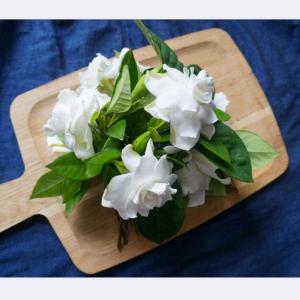
1病虫害严重
这个相信大家都能理解,病虫害严重势必造成落花落蓄。
2水肥不当
水肥一旦过量,就会引起植株徒长,生殖生长没有足够的养分就会影响花芽形成,导致不开花或开花很少,有的开了,甚至会马上脱落。在花芽分 化期要特别注意磷、钾肥的搭配,比如0.2%磷酸二氢钾溶液,有利于花芽的形成和孕蕾;孕蕾期施肥过浓,浇水忽多忽少,也会造成落花落苗。
3光照不适宜
栀子花喜阴,要特别注意夏季过强和冬季过弱的光照,光照过强过弱都会影响桅子花开花.
4土壤含碱高
栀子花喜欢酸性土壤,栽培桅子花土壤含盐含碱高,就会造成植株黄化,最终会影响开花。
5杂枝过多
不修枝整形,栀子花枝条杂乱,大量的杂枝消耗大量的养料以及枝条过密,影响光合作用,都是造成不开花的重要原因。

0
0





